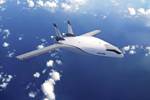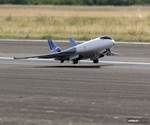JetZero accelerates BWB airliner development with $235 million Air Force award
The commercial/military composite aircraft design will offer a 50% reduction in fuel burn and emissions with potential for future conversions to hydrogen.
An artist’s rendering of the JetZero commercial jetliner derivative of the company’s Air Force BWB technology demonstrator. Photo Credit: JetZero
The U.S. Air Force is investing in ’s (Long Beach, Calif., U.S.) all-composite blended wing body (BWB) aircraft design, which is said will reduce fuel consumption, cut emissions and noise and provide an improved airline passenger experience. The company will build a full-scale demonstrator to validate BWB performance.
JetZero’s demonstrator, the first in a proposed family of BWB aircraft, uses current engines and systems. The BWB aircraft, a design that has been under study by NASA and others for three decades, lends itself to conversion in the future to hydrogen propulsion, which would produce zero carbon emissions.
Under the terms of the award from the Department of Defense’s (DoD) Defense Innovation Unit (DIU), JetZero will receive $235 million over a 4-year period, culminating in first flight of its full-scale demonstrator by the first quarter of 2027. The DIU was founded in 2015 to help the U.S. military make faster use of emerging commercial technologies.
JetZero is collaborating with Northrop Grumman (Denver, Colo., U.S.) and Scaled Composites (Mojave, Calif., U.S.), that bring extensive experience in advanced aircraft design, manufacturing, and mission systems integration to build and test the demonstrator. In addition, JetZero has selected Pratt & Whitney (East Hartford, Conn., U.S.) GTF engines to power the demonstrator, with Pratt & Whitney Gatorworks supporting JetZero with design and integration of the propulsion system within the demonstrator.
“The BWB is the best first step on the path to zero carbon emissions. It offers 50% lower fuel burn using today’s engines and the airframe efficiency needed to support a transition to zero carbon emissions propulsion in the future,” JetZero CEO Tom O’Leary says. “No other proposed aircraft comes close in terms of efficiency.”
JetZero is leading efforts to expand BWB technology and demonstrate its capabilities for the future of aviation and the climate for both military and commercial markets.
Related Content
-
Automated robotic NDT enhances capabilities for composites
Kineco Kaman Composites India uses a bespoke Fill Accubot ultrasonic testing system to boost inspection efficiency and productivity.
-
Plant tour: Aernnova Composites, Toledo and Illescas, Spain
RTM and ATL/AFP high-rate production sites feature this composites and engineering leader’s continued push for excellence and innovation for future airframes.
-
The potential for thermoplastic composite nacelles
Collins Aerospace draws on global team, decades of experience to demonstrate large, curved AFP and welded structures for the next generation of aircraft.






